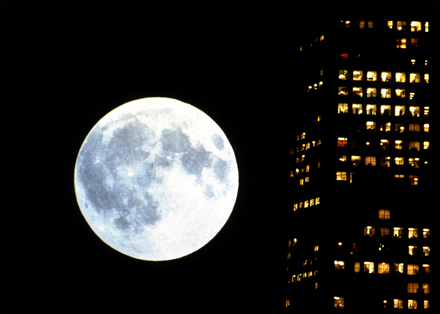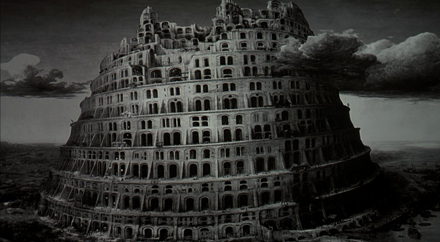
 |
|
|
|
The films of Godfrey Reggio's Qatsi trilogy are artistic efforts that resist evaluation in conventional terms. Technically documentaries, they have no narration and no stated intention beyond opening statements that offer cryptic 'definitions' of the Hopi words that are their titles. Festival audiences in 1983 were unprepared for Koyannisqatsi's non-verbal onslaught of dazzling images and hypnotic music, courtesy of composer Philip Glass. They accepted Reggio's film as an all-enveloping audiovisual experience, even without understanding its message of a natural world thrown out of balance by modern technology. Six years later Reggio found studio backing for the mysterious Powaqqatsi, a more directly humanistic statement about the technologically advanced Northern Hemisphere exploiting the less developed peoples to the South. And finally in 2002 Reggio's Naqoyqatsi found a limited release. It took the third step to show mass visual communication as a weapon that digitally quantifies human values and forces natural cultures into consumer-driven political conformity. Given a spotty release history on home video, Reggio's The Qatsi Trilogy is now a comprehensive 3-disc Blu-ray set from Criterion, which has appointed the films with a wealth of insightful extras. Godfrey Reggio is listed as a director of experimental documentaries, but his background encompasses a life devoted to social work and spiritual meditation. An organizer of community health clinics and an activist for political causes, Reggio has made his artistic works a direct extension of his beliefs. He readily acknowledges that his films are really made by his technical collaborates and the 'star' composer Philip Glass, yet the three pictures in his trilogy carry the same philosophy. Reggio's beliefs are no whim: he spent fourteen years in prayer and fasting training to become a monk, before changing his career goals. 
Koyannisqatsi (Hopi for "Life Out of Balance") is best known for setting Philip Glass's mesmerizing "repetitive structure" musical compositions to time-lapse cinematography. Camera innovator Ron Fricke would go on to direct his own image-based documentaries, sometimes in 65mm: Chronos, Baraka, Samsara. Typical shots show clouds skating across vast landscapes, accelerated traffic patterns in New York City and masses of people surging forth like insects through train station turn-styles. These images indeed evoke the idea of humanity forced into artificial patterns. Considerable running time is taken up by previously filmed stock footage, such as the launching and detonation of a rocket. But the dominant material is the time-lapse footage that expresses the feeling of a world gone mad. The most lyrical entry in the trilogy is 1988's Powaqqatsi ("Life in Transformation"), which was produced with the help of Francis Ford Coppola and George Lucas, with distribution set through, of all companies, Cannon Films. With all-new footage filmed around the globe, Powaqqatsi's political messages are more direct. Originally titled "North / South: Powaqqatsi", it is a powerful indictment of the developed world's exploitation of the poor of less developed countries. The show begins with a staggering sequence of mud-soaked Brazilian laborers hauling huge bags of earth out of a diamond mine. We then see images of modern indigenous peoples at work as farmers and townspeople to illustrate the development of mankind through various stages of social organization. Breathtaking images of Peruvians, Egyptians and Indians harvesting wheat and fishing the seas present a vision of natural harmony. Philip Glass's repeated percussion patterns and droning rhythms make use of instruments and voices from the Third World to form a tapestry of cultural influences. The latter sections of the film document the encroachment of exploitative industries, militarism and economic neglect on vast populations of the poor, with often-terrifying images of backbreaking labor and children working adult jobs. Glittering neon cities are ringed with terrible slums; the Television bombardment of propaganda and consumer luxuries contrasts with lives spent in filth and desperation. Reggio's implied alternative to this Hell on Earth is spirituality, seen in peaceful, harmonious and finally mysterious images of a variety of religions. 
Also setting Powaqqatsi apart is its reliance on the opposite of time-lapse cinematography, slow motion. Many shots run at half speed or slower, allowing us to analyze the motion of legs at labor or to gaze at facial expressions that range from quizzical & smiling children to wrinkled and angry adults. Cameramen Graham Berry and Leonidas Zourdoumis use superimpositions to suggest a 'spirit world' existing within reality. They also alter the shutter speed within a single shot to slowly transform an endless procession of ore cars from crisp motion to a blur. The only aspect that hurts Reggio's film is the lack of identification of what we are looking at, at any particular moment. Viewers may not realize that shots of dancing villagers come from cultures on three continents, or they may be suspicious of image manipulation to make certain political points. A slow-motion telephoto shot shows an Egyptian boy walking on a road, and overtaken by a large truck that leaves him invisible in a cloud of dust. The whole thesis of Powaqqatsi can be distilled to that image, but we have no information about the shot's exact context. Elsewhere, we're shown 'checklist' images of garbage being poured into a river and miserable people searching for scraps on a garbage heap. Selectively superimposed in the final montage is an unconscious man being carried up out of the muddy diamond mine on the shoulders of other worker-slaves. It's instantly recognizable as an image of Christ carried on the cross. 2002's Naqoyqatsi ("Life as War") is an even more pessimistic assessment of the state of the world, a post-PC, post-Internet visual tract decrying the science-fiction transformation of humanity into a homogenized mass of pliable consumers, entertained, distracted and manipulated by a constant barrage of consumer pitches, meaningless glamour and information overloads. Reggio's own message is that industries and governments are waging a war of ideas on humanity. The resulting cacophony is comparable to the Biblical Tower of Babel, the film's first image. 
Naqoyqatsi is produced in HD video, so in addition to composer Philip Glass, Reggio's closest collaborator this time out is editor, second unit director and visual designer Jon Kane, a master manipulator of digital images. Reggio and Kane bombard us with 89 minutes of loaded images arranged into seven musical movements. Newly shot material and stock footage are subjected to radical image manipulations -- colorizing, tinting, texturizing -- that makes exact origins obscure. Lacking the organic beauty of its predecessors Naqoyqatsi instead constructs montage-based Kino-speak visual links to form nonverbal messages. The technique is sophisticated but the messages are surprisingly easy to decode. A chapter about the false values of TV propaganda contains images of money, flags, gambling, real celebrities, computer-generated 'celebrities', Hollywood, space heroes and sports heroes. A baby floating in space is compared to the infantile joy of winners on the playing field. Beginning and ending the sequence are shots of computer-generated wisps of smoke, suggesting that these illusions are all generated "out of pure smoke." This literal approach to imagery runs counter to the mystery of the earlier Qatsi films. Each breathtaking image in Powaqqatsi presents its own specific meaning and context before being added to a particular narrative argument. In Naqoyqatsi the images are a rigid lecture. The film is both compelling and honest, but it has the structure of pure propaganda. Images of genetic manipulation are followed by a quick shot of ... a sheep. Reggio knows that his informed audience will immediately identify the animal as the famous cloned sheep, Dolly. Reggio and Kane bombard us with parades of corporate logos, religious symbols and political symbols. Artwork using digital sequences of zeroes and ones reminds us that 'soulless' High Technology makes all of this remote control of humanity possible. Many of Jon Kane's montages and altered visuals are brilliant. At one point we see a parade of grand artworks 'melting-morphing' into one another in a way that is fascinating, and expressive: a few keystrokes can manipulate and trivialize great world art that took lifetimes to create. A final chapter uses digital effects to maroon skydivers in outer space, an extended metaphor that suggests that man is painting himself into a lonely corner of sterile existence, in a completely unnatural environment. Criterion's 3-disc Blu-ray set of The Qatsi Trilogy contains three dazzling HD encodings of these beautiful visual documentaries. What's more impressive is that Criterion had to license the films from separate rights holders, something usually considered financially prohibitive. With its frequent use of older stock footage Koyannisqatsi has some images of higher granularity but Powaqqatsi constantly amazes with its brilliant color. All three scores are presented in 5.1 surround stereo, remixed from original elements. Except for some sound effects, Philip Glass's music compositions are the only audio on the films. Disc producer Kate Elmore packs the three Blu-ray discs with extras. Godfrey Reggio, Phillip Glass, Ron Fricke, Jon Kane and cellist Yo-Yo Ma (a contributor to Naqoyqatsi) hold forth in various interviews and television show excerpts. Godfrey Reggio's backstory is covered in material about his 1970s multimedia privacy campaign in New Mexico, which includes television spots. A 40-minute demo version of Koyannisqatsi with soundtrack input by Allen Ginsberg is present, and also the entire 28-minute Reggio film Anima Mundi, filmed after Powaqqatsi and featuring another Philip Glass score. Also included are trailers and a 36-page insert booklet with essays by Scott MacDonald, music critic John Rockwell and environmentalist BIll McKibben.
On a scale of Excellent, Good, Fair, and Poor,
The Qatsi Trilogy Blu-ray rates:
Footnote: 1. Powaqqatsi holds a place of pride for DVD Savant. Early in 1987 I was hired to cut promos and trailers at Cannon Films, a place that turned out to be a hotbed of editorial talent. The tricks used at Cannon to hype movies with no commercial selling points later became the industry standard. I was kicked into a higher rank of trailer cutters when Godfrey Reggio saw my promo for North/South: Powaqqatsi and asked that I edit the trailer, an assignment coveted by the department's top cutters. I finally met with Reggio, who talked like a cross between a committed film theorist and a less manic Dennis Hopper from Apocalypse Now. Reggio was incredibly sharp and could articulate complex ideas extremely well... and had my mind racing to remember the semiotic jargon from Howard Suber's critical studies classes film school. I was able to fashion a complex optical for the trailer (included on Criterion's disc, albeit flat) and in a burst of self-promotion contacted the magazine Adweek. Would they be interested in an article on the selling of a non-commercial art film from the maker of Koyannisqatsi? You bet. The color article won me invitations to work at various high-end trailer houses just when Cannon was imploding. My department head was keeping the shop open by having me work very slowly on stuff like American Ninja 3. Before I knew it I was cutting a vastly overpriced exhibitor's promo for The Abyss, to be finished in 70mm. About 14 months earlier I was assistant editing on Mattel and Denny's commercials, and going exactly nowhere... Cannon chieftain Yoram Globus apparently hadn't a clue as to how to distribute or market Powaqqatsi. As I was the only one there that really knew anything about the movie, I was dragged to his office to give a presentation on my ideas. I talked them into using the image of the boy on the road as the key graphic. When producer Mel Lawrence arrived a few weeks later with final prints of the film, he thanked me for doing a good job and gave me a rare Koyannisqatsi poster. My time cutting trailers was relatively short, yet the experience gave me a sense of accomplishment lacking in earlier "I was there" film assignments.
Reviews on the Savant main site have additional credits information and are often updated and annotated with reader input and graphics. Also, don't forget the 2011 Savant Wish List. T'was Ever Thus.
Review Staff | About DVD Talk | Newsletter Subscribe | Join DVD Talk Forum |
| ||||||||||||||||||